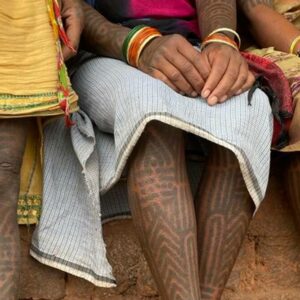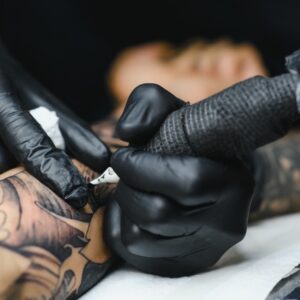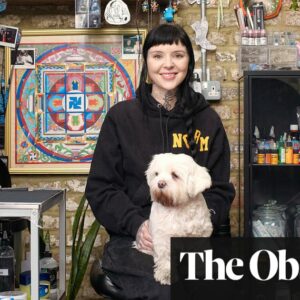For some, it is a way to commemorate something significant, and for many others, it is a fashion statement, but whatever the reason may be, tattoos continue to arouse curiosity and interest in the urban landscape. But, you might be mistaken if you believe that tattooingis a modern phenomenon; this art has been popular in the Indian subcontinent for ages. From the Khoibu tribe of the northeast and the Toda tribe of the Niligirs to the Baiga tribe of Madhya Pradesh — the rich cultural tradition of tattooing or godna, as it is popularly known, has been venerated by several communities across the country for various religious, ornamental, and healing purposes.
Despite their widespread prevalence among several agrarian and forest communities, tribal tattoos continue to remain restricted to small villages and towns, and little is known about them. This is what M Sahana Rao, an independent curator in the field of arts and culture, set out to change after a chance meeting with Mo Naga, a Naga art and culture revivalist, as it was only then that she became aware of various traditional tattoopractices in India, their rapid disappearance, and Mo’s quest to revive them.
“With him and Mangla Bai, a tattoo artist from the Baiga tribe, I decided to give shape to Godna Project,” she told indianexpress.com, adding that her project is “an attempt to bring indigenous tattoo artists together and present them to a diverse crowd to inculcate curiosity and appreciation for the rich cultural heritageof their country”.
The project also hosted an event in Delhi earlier this month, which brought together five indigenous tattoo artists from across India to document, discuss, and experience the significance and relevance of the rapidly disappearing art of traditional tattoo practices and its practitioners. “Indigenous tattoos are rapidly disappearing. There are only a few communities who still know what their community tattoo practices are,” she said, explaining that tattoos have been done by various tribes for many common reasons. “It is a marker of one’s community identity — to say who I am and where I come from; for healing — they are done in certain areas as acupuncture to heal issues such asjoint pain, for ornamentation purposes; and to immortalise something.”
Delving deeper into the tattoo practices of India, Mo Naga, who belongs to the Khoibu (Uipo) tribe, said there are primarily three ways tattoo are made by indigenous communities. “In other parts of India, the traditional way of tattooing is hand poking, but in the northeast, the technique is hand tapping. On rare occasions, we also practise hand poking. One of the rarest practices of traditional tattooing, which can only be found in the northeast among the Naga people, is hammering,” he shared, adding that in contrast to the machines used nowadays, indigenous tattooists continue to practice the traditional way of engraving.
“Tattooing technique involves two sticks – on one stick, the needle is tied and fitted and the other stick is used to hit the first stick. The needle pushes the pigment into the skin. This hand tapping. In hand poking, the needle is tied to the sticks together, you dip it into the ink and push the pigment into the skin. In hammering, you use just one stick on which the needle is attached and use it like a hammer,” Mo Naga explained.
Tattoos, for these indigenous tribes, mean a lot more than a fashion statement that they have become in the urban space. “This art form is very important for us because tattoos are the markers of our identity, our belief system, and our relationship with the natural world and the community. Most importantly, through this and other art forms, we can understand our aesthetics and expressions,” Mo Naga said.
Among men and women of the Baiga tribe, who can be seen sporting elaborate tattoos on their forehead, arms, legs, back, neck and breasts, tattoos are strongly linked to a belief that it is the only ornament that they can carry with them after death. “When we die, nothing goes with our body except these tattoos,” Mangla Bai said.
For women, especially, tattooing begins early — around the age of eight, and is an important ornament. “For girls, it is considered a form of ornamentation. Even gold and silver do not hold as much value as godna does,” Shanti Bai, a tattooist from the Baiga community, was quoted as saying by MP Tourism.
Tattoo is also used by many to mark important milestones in one’s life journey. “Sometimes, people would get them on special occasions like on the journey of a boy becoming a man, a girl becoming a woman, becoming a mother, etc. Life journeys marked through tattoos tell life stories of that person and the place they belong to,” Mo Naga said.
“There are various types of godna practised in the central part of the country – birchha, poothi, tipka etc,” Mangla Bai shared. “They are different in terms of designs.”
So, what kind of designs do these indigenous tattooists make? “The motifs are very specific to the tribe. Different communities have different designs which make them unique and become their identity,” Mo Naga said.
“In the Baiga tribe, the motifs include bull’s eye, chakmak, fish’s scale, honeycomb, etc.,” Mangla Bai added. Sahana, in her research, found that traditional tattoo motifs include popular Hindu symbols and folk motifs, in addition to those particular to the community. “They are usually very simple dotted and geometric patterns,” she said.
Just like the designs and purpose, indigenous tattoos are also made using different ink and equipment. “We use thorns from different plants, depending on the tribe. After collecting pigments from the plants, it is then mixed with carriers such as water, rice beer, and other liquid media. Everything comes from nature,” Mo Naga said.
Agreeing, Mangla Bai added that while ink and equipment were derived from plants earlier, things have changed gradually. “Earlier, people would take pigments from plants. Now, we use a ramtila crop from which we extract edible oil. This oil is what we use to make ink. We now use needleswhich are easily available in the market. Earlier, people would take thorns from the plants,” she said.
However, what once used to be a common sight on the bodies of tribal people has now become rare. Their rapid disappearance has become a cause of concern as many communities fail to recall their tattoo practices, Sahana said. “Like, The Toda community had quite a prevalent tattoo practice but now they don’t recall the same anymore,” she said.
A quick search on the internet would make many realise that tattoos used to be central to this pastoral tribe with their arms, legs and faces flaunting varied geometrical patterns. So, what accelerated the disappearance of such tattoos from the Indian landscape? “Due to colonisation and the spread of other beliefs such as Christianity, these tattoo practices took a backseat. Earlier tattoos were used to adorn bodies as people didn’t wear a lot of clothes. Now, that’s not the case. With globalisation and students going to the same schools and colleges, young people aren’t comfortable getting these tattoos on their bodies anymore,” she added.
Agreeing with Sahana, Mo Naga elaborated on the causes behind the fading of this traditional art form. “It started with the outside force – the colonisers – who wanted to control us in the name of civilisation. The Indian military force continued the banning of tattoos even after the white men left because they also wanted to control. But, the main reason it stopped is the new belief system that spread through a new religion – Christianity. It teaches people not to have tattoos on their bodies and that’s why people stopped,” he told indianexpress.com.
Due to this, this art and its practising artists are struggling to survive. “We struggle to meet our ends meet due to the rapid disappearance of this art. As such, we have started making tattoos on papers, canvases and walls,” Mangla Bai said, adding that she has created tattoos in various places in Bhopal and will soon head to Khajuraho for the same.
Artists called for more awareness and government interventions to revive this dying art form. “It is important to make this art accessible to people who still have an interest in it. A museum, funded by the government, where people get it done for free perhaps would make things better,” Mangla Bai said.
Mo Naga, who has been working to revive various Naga art forms since 2007, emphasised that tattooing is not just about the designs and tools. “We need to understand where they come from – nature. It is not just the tattoos that are disappearing but also these plants because they have no purpose for people anymore. They are just weeds now, just like the tattoos,” he said.
📣 For more lifestyle news, follow us on Instagram | Twitter | Facebook and don’t miss out on the latest updates!





